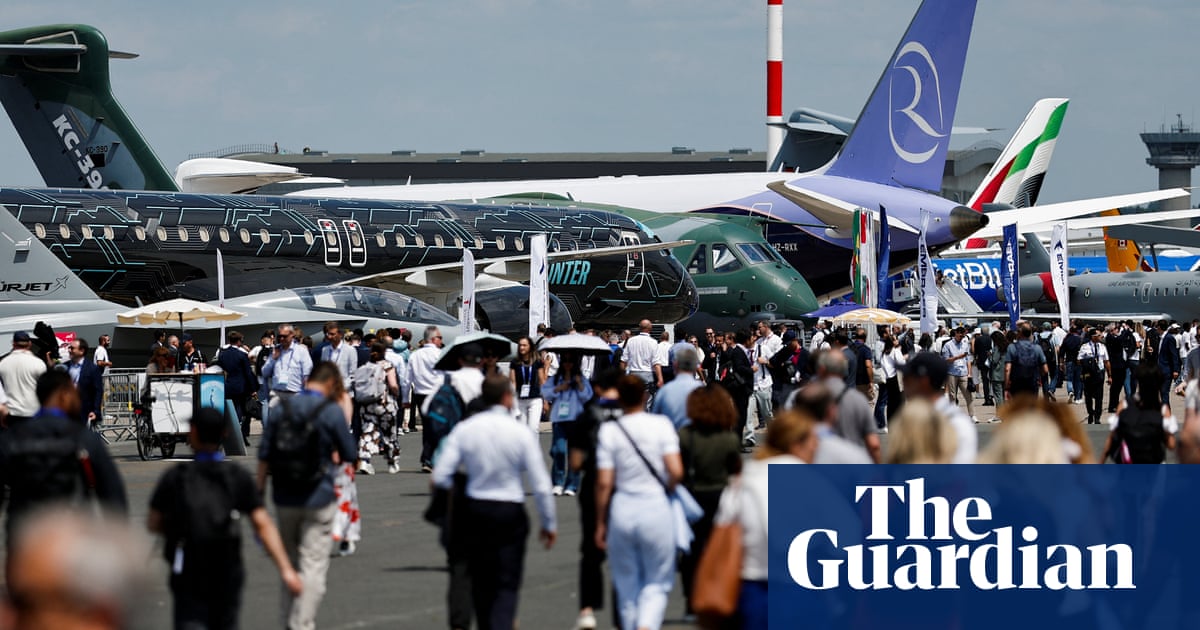Every second summer more than 100,000 aviation industry professionals gather in Paris for an airshow – a flying display crossed with a vast conference. The mood at the latest gathering this week was more subdued than usual, after the deadly crash a week ago of a London-boundAir India flightin Ahmedabad.
Investigators have recovered the black boxfrom the plane to try to work out the cause of the disaster. The aircraft makerBoeing, and GE Aerospace, which made the 787 Dreamliner’s engines, both cancelled many of their media-facing events out of respect for the families of the 241 passengers and crew who died, as well as at least 30 more people on the ground who were killed.
At an event that presents a mix of civil and military aircraft and weaponry, the war between Israel and Iran further overshadowed proceedings.
The French government forced the show’s organisers tocover stands exhibiting Israeli companies’ weapons, an apparent show of France’s opposition to the escalation. Turbo Sjogren, the head of Boeing’s international government and defence, said several Middle Eastern military customers were unable to attend meetings because of the war.
The airshow and its British counterpart – held every other year at Farnborough, Hampshire – are usually dominated by a race between Airbus and Boeing to announce the most orders from airlines.
Yet Boeing’s string of crises, includingtwo deadly crashes of the 737 Maxin 2018 and 2019, have meant that Airbus has taken the lead for several years. The Toulouse-headquartered plane maker announced 142 firm orders plus another 102 provisional orders at the show worth a cumulative $21bn (£15.5bn), according to Cirium Ascend, the aviation consultancy.
That compared with zero orders announced by its US rival Boeing. Darren Hulst, a Boeing vice-president for commercial marketing, said: “Our hearts, our thoughts, our prayers are with all the families that have been impacted by this, as well as our partner and our long-term customer Air India.”
Before an investigation shares its findings of the cause of the Air India crash, experts have mostly declined to make a judgment of what the longer-term consequences could be for Boeing.
Yet assessments of the state of the global aviation market suggest that demand for air travel will remain buoyant. Hulst predicted that 43,600 new planes will be needed through to 2044.
“As we look to the end of this decade, by 2030, our industry will be about 45% larger than it was in the years before the pandemic,” he said.
The majority of those deliveries will be “narrowbody” planes with a single aisle, such as Airbus’s A320 and the 737 family. Other companies are positioning to take advantage of that growth. Perhaps most notably, Britain’s Rolls-Royce, now a specialist in powering the biggest “widebody” planes, wants tomake engines for the much bigger narrowbody market.
Tufan Erginbilgic, Rolls-Royce’s chief executive, told reporters that the UK government should part-fund the development of the company’s next generation of jet engines, known asUltraFan. In a direct pitch to the government, he argued that winning orders for narrowbody engines could create 40,000 jobs.
“If you look at single-aisle, narrowbody entry could be the single biggest item for economic growth for UK, because it is that big. This is a huge market, right? A £1.6tn market.”
Ahead of the UK’s industrial strategy, expected to be published on Monday, Erginbilgic argued that the government should target support at industries where the country is strongest, which he said included Rolls-Royce’s gas turbines and small modular nuclear reactors (SMRs).
Rolls-Royce’s part-owned subsidiary was chosen this monthto try to build the first UK SMRs, with the first formal contract expected before October.
Sign up toBusiness Today
Get set for the working day – we'll point you to all the business news and analysis you need every morning
after newsletter promotion
“I believe any country needs to support competitively advantaged industries,” Erginbilgic said. “If you support competitively advantaged industries, your position in the market will be sustainable. Because it is already competitively advantaged. If you give some momentum, that will create lots of export growth, etc, and employment with that.”
Rolls-Royce is also a key player in the UK’s defence strategy. Erginbilgic said the government’s recent strategic defence review and pledges to increase military spending to 2.5% of GDP had “de-risked our key programmes”, all but guaranteeing demand for more nuclear reactors for attack submarines and engines for the future Tempest jet, officially known as the global combat air programme (GCAP), whosecosts are shared between the UK, Italy and Japan. Erginbilgic also said that the review’s emphasis on autonomous drones could mean future opportunities for Rolls-Royce to power them.
The UK is not the only European country rearming in response to the perceived threat from Russia after its invasion of Ukraine. Yet the Paris airshow also revealed deep tensions in another key European weapons project: a rival “sixth-generation” fighter jet programme between France, Germany and Spain.
Éric Trappier, chief executive of France’s Dassault, maker of the previous-generation Rafale jets that were on show in Paris, told Bloomberg TV that “we may go it alone” amid frustrations over who should lead.
Michael Schoellhorn, chief executive of Airbus’s Germany-based defence division, said that political intervention might be needed to solve the dispute.
Nevertheless, the European government consensus is that military spending must increase – particularly if the US under Donald Trump cannot be relied upon for support.
Deals at the show included Rheinmetall teaming up withcontroversial US drones startup Andurilto produce weapons in Germany, while Italy’s Leonardo formalised a joint drones venture with Turkey’s Baykar. With renewed war in the Middle East, defence bosses in Paris were keen to move quickly with manufacturing more lucrative weapons on European soil.
